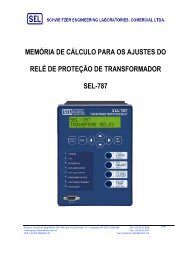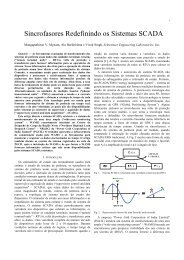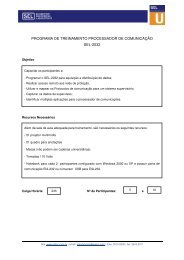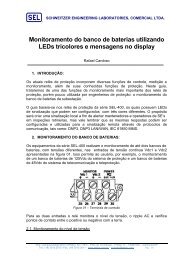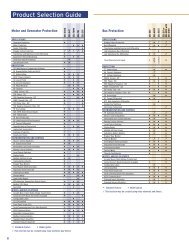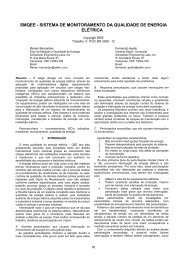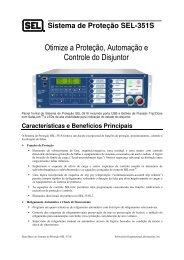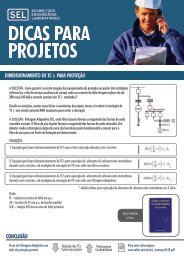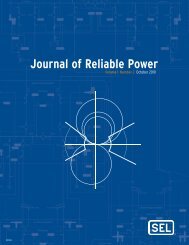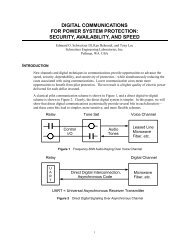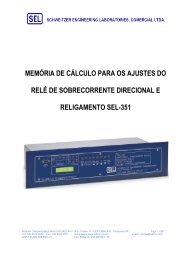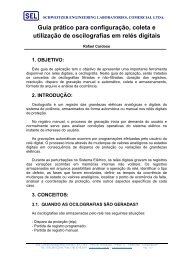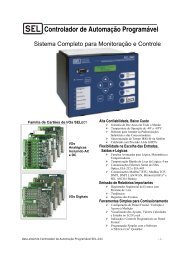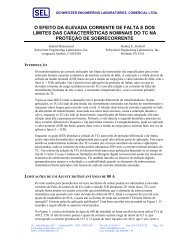Journal of Reliable Power - SEL
Journal of Reliable Power - SEL
Journal of Reliable Power - SEL
You also want an ePaper? Increase the reach of your titles
YUMPU automatically turns print PDFs into web optimized ePapers that Google loves.
17<br />
Fig. 34 and Fig. 35 illustrate the adaptive behavior <strong>of</strong> the<br />
quadrilateral distance element. Because these figures are for<br />
illustrative purposes, the power system impedances, fault<br />
location, and/or Rf value are not relevant to the discussion.<br />
These two figures simply illustrate the adaptive behavior <strong>of</strong><br />
the reactance and resistive lines.<br />
The fault type is a ground fault; and the ground<br />
quadrilateral element is formed with a reactance line polarized<br />
with negative-sequence current (the preferred polarization).<br />
The two resistance elements are polarized with negative<br />
sequence (I2) and with the alpha component (I1 + I2). The<br />
polarization is what makes the lines adaptive, as explained in<br />
the previous sections.<br />
Fig. 34 and Fig. 35 provide a wealth <strong>of</strong> information about<br />
the behavior <strong>of</strong> these impedance lines, including the<br />
following:<br />
• The reactance element pivots on the line impedance<br />
reach, and that point is fixed. The resistance elements<br />
pivot on the resistive reach, which is a setting.<br />
• The degree at which these lines tilt is determined by<br />
the power system parameters and operating<br />
conditions. These include line impedances, load flow,<br />
and Rf.<br />
• The mho circle and reactance line tilt at the same time<br />
and in the same direction.<br />
• The resistance element trip decision is the OR<br />
combination <strong>of</strong> either resistive line. Their behavior is<br />
dependent on the direction <strong>of</strong> the load flow, and their<br />
operation is complementary to each other.<br />
For the forward load flow terminal in Fig. 34, we conclude:<br />
• The reactance element tilts beneficially in a clockwise<br />
direction. This behavior prevents overreaching<br />
because <strong>of</strong> high-resistance load flow.<br />
• The resistance element polarized with negativesequence<br />
current will adapt to provide better resistive<br />
reach coverage. This resistive line will make the<br />
decision for faults with load in the forward direction.<br />
• The resistance element polarized with the alpha<br />
component current tilts in the opposite direction. The<br />
resistive coverage <strong>of</strong> this characteristic is less effective<br />
compared to the other resistive line.<br />
For the reverse load flow terminal in Fig. 35, we conclude:<br />
• The reactance element moves in the direction that the<br />
apparent impedance locus moves, as shown in Fig. 10.<br />
• The resistance element polarized with negativesequence<br />
current moves in the opposite direction and<br />
with less resistive coverage.<br />
• The resistance element polarized with the alpha<br />
component provides more effective coverage and will<br />
detect the fault.<br />
VI. CONCLUSIONS<br />
<strong>Power</strong> system faults present different values <strong>of</strong> Rf. Ground<br />
faults present a larger value <strong>of</strong> Rf because <strong>of</strong> the arc resistance<br />
and tower footing resistance.<br />
Short line protection applications with distance elements<br />
favor the use <strong>of</strong> quadrilateral distance elements for phase and<br />
ground fault protection. The expected Rf for short lines can be<br />
in the same order <strong>of</strong> magnitude as the impedance <strong>of</strong> the<br />
transmission line.<br />
Rf and power flow have the effect <strong>of</strong> modifying the<br />
apparent impedance measured by the distance element. The<br />
description <strong>of</strong> the Rf influence was plotted for different Rf<br />
values and load flows.<br />
Especially for short lines, quadrilateral distance elements<br />
can detect faults with higher Rf than mho distance elements.<br />
Instrument transformers and relay measurement errors limit<br />
the Rf coverage in short line applications.<br />
An adaptive characteristic for ground and phase<br />
quadrilateral distance elements was presented. The reactance<br />
element, polarized with negative-sequence current, adapts<br />
based on the direction <strong>of</strong> the load flow and prevents<br />
overreaching issues associated with load flow in the forward<br />
direction. Resistance elements are polarized with two<br />
quantities simultaneously. The negative-sequence polarization<br />
has a better Rf coverage for forward load flow. Using ground<br />
distance (alpha component) and phase distance (positivesequence<br />
component) provides better coverage for faults with<br />
reverse load flow. For the resistance elements, running two<br />
polarizations at the same time helps to detect as much Rf as<br />
possible.<br />
A high-speed version <strong>of</strong> the quadrilateral elements<br />
typically improves the speed <strong>of</strong> operation by half a cycle.<br />
These elements are required in applications where high-speed<br />
tripping times are required. These elements provide subcycle<br />
operating speeds and operate reliably during open-pole<br />
conditions.<br />
The paper presented an improved distance element with an<br />
adaptive quadrilateral characteristic that can be part <strong>of</strong> a line<br />
protection relay.<br />
The performance <strong>of</strong> the adaptive quadrilateral distance<br />
element was compared to a previous quadrilateral<br />
implementation, showing the benefits. A graphical illustration<br />
<strong>of</strong> the performance expected from the reactance and resistive<br />
lines was presented with an example in Fig. 34 and Fig. 35.<br />
The Rf coverage <strong>of</strong> the adaptive quadrilateral element<br />
increases for terminals with forward direction load flow.<br />
The phase quadrilateral distance elements presented in this<br />
paper are suitable for any transmission line application, but<br />
because <strong>of</strong> their nature, they fit better in short line<br />
applications. No distance element, however, can provide better<br />
sensitivity and Rf coverage than directional overcurrent<br />
elements in a pilot scheme.<br />
Adaptive Phase and Ground Quadrilateral Distance Elements | 81



